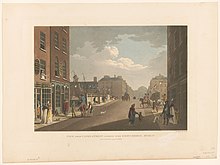Capel Street
 | |
| Native name | Sráid Chéipil Error {{native name checker}}: parameter value is malformed (help) |
|---|---|
| Namesake | Arthur Capell, 1st Earl of Essex |
| Length | 600 m (2,000 ft) |
| Width | 14 metres (46 ft) |
| Location | Dublin, Ireland |
| Postal code | D01 |
| Coordinates | 53°20′54″N 6°16′07″W / 53.348438°N 6.268745°W |
| north end | Bolton Street |
| south end | Ormond Quay |
| Construction | |
| Completion | 1670s |
| Other | |
| Known for | restaurants, shops, cafés and pubs; immigrant community |
Capel Street /ˈkeɪpəl/ is a street in Dublin, Ireland.[1][2]
History

It is sometimes claimed that the street takes its name from the chapel of St Mary's Abbey; other Capel Streets may be named after chapels, but this one is named after Arthur Capell, 1st Earl of Essex, Lord Lieutenant of Ireland 1672–1677. Built by Sir Humphrey Jervis in the late 17th century, he also built Essex Bridge (today Grattan Bridge), and the street was known for its mansions and a royal mint. In the 18th century it became a commercial hub, with two-bay buildings replacing the "Dutch Billy" houses.[3] The Capel Street Theatre also stood there in the 18th century.
The Torch Theatre operated on Capel Street in 1935–41. The street declined in the 20th century, before a revival around the 1980s. Today it is known for its variety of restaurants, shops, cafés and pubs; as Panti, the owner of Pantibar put it, "You can buy a lightbulb, sexual lubricant, Brazilian rice, get a pint and go to a trad session." Louis Copeland's tailor is another notable business.[4][5][6]
Gallery
-
Berlin Optician, 157 Capel Street
-
Site of the Torch Theatre, 114–116 Capel Street
-
Slattery's Bar, 129 Capel Street
-
Jack Nealon's pub, 165 Capel Street
See also
References
- ^ "Lovin Dublin City Spotlight - Capel Street". LovinDublin.com.
- ^ Greene, John C.; Clark, Gladys L. H. (February 9, 1993). "The Dublin Stage, 1720-1745: A Calendar of Plays, Entertainments, and Afterpieces". Lehigh University Press – via Google Books.
- ^ Oram, Hugh. "Capital vision – An Irishman's Diary on Capel Street". The Irish Times.
- ^ "Capel Street: Why Dublin's black sheep is its most brilliant street". independent.
- ^ "Dublin Uncovered: Capel Street".
- ^ "The Capel Street Series #1". DublinTown. August 27, 2014.





